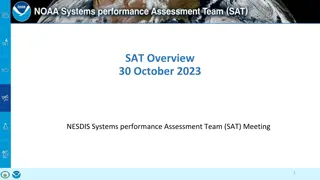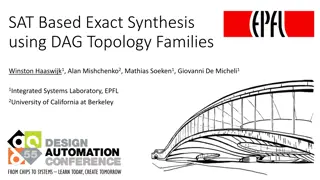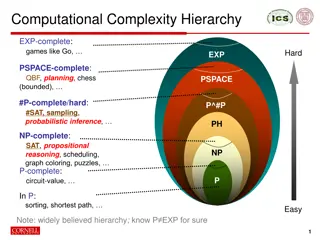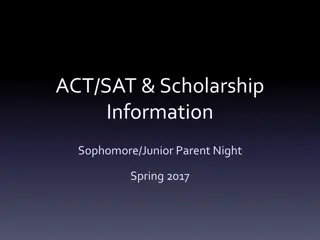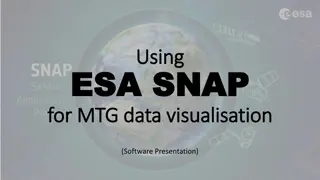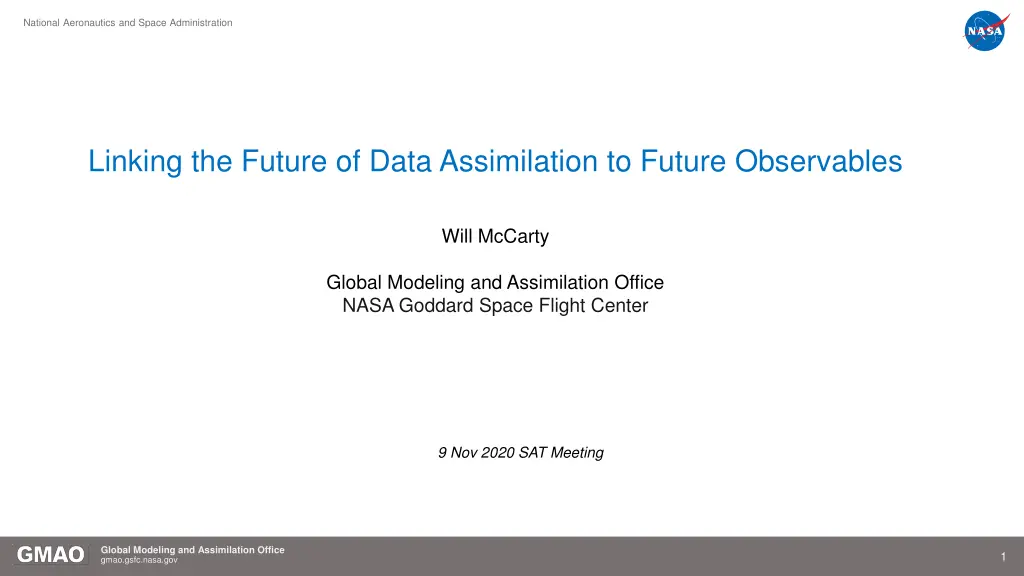
Future of Data Assimilation and Observables in Space Science
Explore the future of data assimilation and observables in space science through NASA's Global Modeling and Assimilation Office. Learn about the advancements in Earth system modeling, upcoming technologies, and efforts to bridge the gap between different forecasting scales. Discover how NASA is moving towards a JEDI-based GEOS system and unifying data assimilation for improved accuracy and efficiency in understanding our planet's systems.
Download Presentation

Please find below an Image/Link to download the presentation.
The content on the website is provided AS IS for your information and personal use only. It may not be sold, licensed, or shared on other websites without obtaining consent from the author. If you encounter any issues during the download, it is possible that the publisher has removed the file from their server.
You are allowed to download the files provided on this website for personal or commercial use, subject to the condition that they are used lawfully. All files are the property of their respective owners.
The content on the website is provided AS IS for your information and personal use only. It may not be sold, licensed, or shared on other websites without obtaining consent from the author.
E N D
Presentation Transcript
National Aeronautics and Space Administration Linking the Future of Data Assimilation to Future Observables Will McCarty Global Modeling and Assimilation Office NASA Goddard Space Flight Center 9 Nov 2020 SAT Meeting Global Modeling and Assimilation Office gmao.gsfc.nasa.gov 1
National Aeronautics and Space Administration The Future of Observations in Earth System Modeling A broader perspective... These slides attempt to layout the utility of future observations in the context of future modeling and assimilation systems beyond the standard application of T & qv sounding I m attempting to put this in the general context of the science, applicable to NOAA, NASA, and beyond But this does have a GMAO perspective baked in As the systems progress, the gaps between global medium-range forecasting and subseasonal-to-seasonal forecasting collapse Just as the gaps between regional and global forecasting collapse Global Modeling and Assimilation Office gmao.gsfc.nasa.gov 2
National Aeronautics and Space Administration Moving toward a JEDI-based GEOS system for coupled DA 9-km Grid Nonhydrostatic 132 Levels New Microphysics More All-Sky MW New Convection EnKF SPPT New LSM 2024 GMI All-Sky Radiances Updated Radiation 2022 2020 2019 GEOS Unified CDAS JEDI-based S2S v4 GEOS+JEDI Hybrid 4D-EnVar 13-km L72 Aerosols AO Skin SST 2018 2020 NWP Reanalysis S2S Prediction JEDI ODAS MOM6 L72 Hybrid EnVar 2020 2017 S2S v3 MOM5 0.25o L50 Salinity MERRA-2 Ocean Product 2017 S2S v2 MOM5 0.5o L40 CICE4 UMD LETKF Global Modeling and Assimilation Office gmao.gsfc.nasa.gov 3
National Aeronautics and Space Administration Unifying the data assimilation system Up to now GMAO s data assimilation systems have been developed for individual GEOS components as disparate entities. Aerosol PSAS Atmosphere H4DEnVar Aerosol Atmosphere GEOS Disparate data assimilation systems GEOS+JEDI Generic data assimilation algorithms Land EnKF Constituent 3DVar Land Constituent Ocean LETKF Sea Ice Sea Ice Ocean Global Modeling and Assimilation Office gmao.gsfc.nasa.gov 4
National Aeronautics and Space Administration Moving toward a JEDI-based GEOS system for coupled DA 9-km Grid Nonhydrostatic 132 Levels New Microphysics More All-Sky MW New Convection EnKF SPPT New LSM 2024 GMI All-Sky Radiances Updated Radiation 2022 2020 2019 GEOS Unified CDAS JEDI-based S2S v4 GEOS+JEDI Hybrid 4D-EnVar 13-km L72 Aerosols AO Skin SST 2018 2020 NWP Reanalysis S2S Prediction JEDI ODAS MOM6 L72 Hybrid EnVar 2020 2017 S2S v3 MOM5 0.25o L50 Salinity MERRA-2 Ocean Product 2017 S2S v2 MOM5 0.5o L40 CICE4 UMD LETKF Global Modeling and Assimilation Office gmao.gsfc.nasa.gov 5
National Aeronautics and Space Administration NWP Evolving from Atmosphere to Earth System Observational Advances NWP Considerations Atmosphere: All-Sky Assimilation Importance of microwave data both window and sounding, particularly @ higher frequencies Is 118 GHz the path to Small MW constellation? (NASA TROPICS, OMS GEMS) Future looking studies need to consider the all-sky impact, not just clear sky (OSSEs lack here) What helps beyond initial conditions? Model improvements aren t solely driven by initial conditions Initial conditions can t always fight systematic errors in parameterizations Parameterizations tuned against systematic IC errors Cloud radars, precip radars, polarized radio occultation? Also leads towards parameter estimation Allowing data assimilation to add dynamic adjustment to parameterization tuning Global Modeling and Assimilation Office gmao.gsfc.nasa.gov 6
National Aeronautics and Space Administration Moving toward a JEDI-based GEOS system for coupled DA 9-km Grid Nonhydrostatic 132 Levels New Microphysics More All-Sky MW New Convection EnKF SPPT New LSM 2024 GMI All-Sky Radiances Updated Radiation 2022 2020 2019 GEOS Unified CDAS JEDI-based S2S v4 GEOS+JEDI Hybrid 4D-EnVar 13-km L72 Aerosols AO Skin SST 2018 2020 NWP Reanalysis S2S Prediction JEDI ODAS MOM6 L72 Hybrid EnVar 2020 2017 S2S v3 MOM5 0.25o L50 Salinity MERRA-2 Ocean Product 2017 S2S v2 MOM5 0.5o L40 CICE4 UMD LETKF Global Modeling and Assimilation Office gmao.gsfc.nasa.gov 7
National Aeronautics and Space Administration Keys to the Future of S2S Prediction Observational Advances using satellite observations to constrain long-term predictability Ocean: Measurements of Sea Surface Salinity have been shown to impact the initialization of ocean mixed layer depth in the Tropics and ENSO prediction Sea Surface Height altimetry core to ocean prediction Sea Ice Microwave imager bands are the backbone of sea-ice extent Ice altimetry is a more difficult discussion Ice modeling is core to the radiative fluxes over the ice; current work @ GMAO is investigating the importance of aerosol-aware 2-moment microphysics in better constraining those fluxes Needs active aerosol distributions! Climatological aerosols will just continually create clouds without wash-out, and initial aerosol conditions Global Modeling and Assimilation Office gmao.gsfc.nasa.gov 8
National Aeronautics and Space Administration Moving toward a JEDI-based GEOS system for coupled DA 9-km Grid Nonhydrostatic 132 Levels New Microphysics More All-Sky MW New Convection EnKF SPPT New LSM 2024 GMI All-Sky Radiances Updated Radiation 2022 2020 2019 GEOS Unified CDAS JEDI-based S2S v4 GEOS+JEDI Hybrid 4D-EnVar 13-km L72 Aerosols AO Skin SST 2018 2020 NWP Reanalysis S2S Prediction JEDI ODAS MOM6 L72 Hybrid EnVar 2020 2017 S2S v3 MOM5 0.25o L50 Salinity MERRA-2 Ocean Product 2017 S2S v2 MOM5 0.5o L40 CICE4 UMD LETKF Global Modeling and Assimilation Office gmao.gsfc.nasa.gov 9
National Aeronautics and Space Administration NWP Evolving from Atmosphere to Earth System Observational Advances bridging NWP and S2S Atmosphere-Ocean Interface: SST is no longer a fixed boundary condition, but a dynamic interface between a fixed foundation temperature and a dynamic atmosphere Interface layer designed to replace foundation temperature fixed IC to dynamic ocean model Observational constraints dependent on both IR and MW data, and across MW frequency Planetary Boundary Layer As modeling systems move to coupled earth system components, the PBL parameterization becomes increasingly important in how fluxes link the atmosphere, hydrosphere, and lithosphere NASA PBL mission an Incubation-class targeted observable What role does a spaceborne architecture have for PBL? Combination of process verification, initial condition retrieval, advanced assimilation/inverse methods Commonality of all future systems are how earth system components interact both in model and data assimilation Global Modeling and Assimilation Office gmao.gsfc.nasa.gov 10
National Aeronautics and Space Administration NWP Evolving from Atmosphere to Earth System Observational Advances bridging NWP and S2S Commonality of all future systems are how earth system components interact both in model and data assimilation System previously constrained by boundary conditions move from least to most important Near-surface observations now constrain fluxes across earth system boundaries e.g. IR imagery, scatterometry, Global Modeling and Assimilation Office gmao.gsfc.nasa.gov 11
National Aeronautics and Space Administration Global Modeling and Assimilation Office gmao.gsfc.nasa.gov 12

